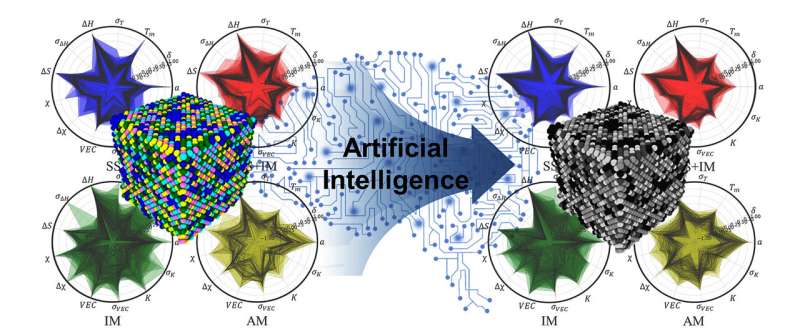New materials that apply AI to develop high-entropy alloys (HEAs) which are coined as alloy of alloys. Credit: Seungchul Lee (POSTECH)
Developing new materials takes a lot of time, money and effort. Recently, a POSTECH research team has taken a step toward creating new materials by applying AI to develop high-entropy alloys (HEAs) which are referred ti as 'alloys of alloys.'
A joint research team led by Professor Seungchul Lee, Ph.D. candidate Soo Young Lee, Professor Hyungyu Jin and Ph.D. candidate Seokyeong Byeon of the Department of Mechanical Engineering along with Professor Hyoung Seop Kim of the Department of Materials Science and Engineering have together developed a technique for phase prediction of HEAs using AI. The findings from the study were published in the latest issue of Materials and Design, an international journal on materials science.
Metal materials are conventionally made by mixing the principal element for the desired property with two or three auxiliary elements. In contrast, HEAs are made with equal or similar proportions of five or more elements without a principal element. The types of alloys that can be made like this are theoretically infinite and have exceptional mechanical, thermal, physical, and chemical properties. Alloys resistant to corrosion or extremely low temperatures, and high-strength alloys have already been discovered.
However, until now, designing new high-entropy alloy materials was based on trial and error, thus requiring much time and money. It was even more difficult to determine in advance the phase and the mechanical and thermal properties of the high-entropy alloy being developed.
To this, the joint research team focused on developing prediction models on HEAs with enhanced phase prediction and explainability using deep learning. They applied deep learning through three perspectives: model optimization, data generation and parameter analysis. In particular, the focus was on building a data-enhancing model based on the conditional generative adversarial network. This allowed AI models to reflect samples of HEAs that have not yet been discovered, thus improving phase prediction accuracy compared to conventional methods.
In addition, the research team developed a descriptive AI-based HEA phase prediction model to provide interpretability to deep learning models, which acts as a black box, while also providing guidance on key design parameters for creating HEAs with certain phases.
"This research is the result of drastically improving the limitations of existing research by incorporating AI into HEAs that have recently been drawing much attention," remarked Professor Seungchul Lee. He added, "It is significant that the joint research team's multidisciplinary collaboration has produced the results that can accelerate AI-based fabrication of new materials."
Professor Hyungyu Jin also added, "The results of the study are expected to greatly reduce the time and cost required for the existing new material development process, and to be actively used to develop new high-entropy alloys in the future."
More information: Soo Young Lee et al, Deep learning-based phase prediction of high-entropy alloys: Optimization, generation, and explanation, Materials & Design (2020). DOI: 10.1016/j.matdes.2020.109260
Provided by Pohang University of Science & Technology
























